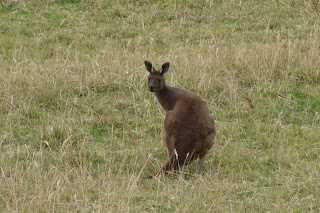The Fleurieu Peninsula is south of Adelaide and named after the French explorer and hydrographer, Charles Pierre Claret de Fleurieu, by the French explorer Nicolas Baudin as he mapped the south coast of Australia in 1802.
At the beginning of our travels today we stopped at the top of a hill in the Adelaide Hills to look down upon the most amazing view of the south coast and Encounter Bay in the Southern Ocean.
Once down at the coast my first stop was at Middleton Beach. Not known as a particularly 'safe' beach for swimmers however, for the experienced surfer it is considered one of the best - although everyone has to be careful with its high waves and strong rips that run up against the rocks. I wasn't swimming today - just enjoying the beauty.
My next stop was at Bashams Beach, another beach that is equally popular with both swimmers and surfers. Here I went for a little walk along the beach and spent some time just watching the waves crash against the rocks.
Next along the coastline was Horseshoe Bay at Port Elliot. This is a lovely, little protected swimming beach area, and a great place for the beginner surfer.
In 1851 Horseshoe Bay was actually proclaimed a port and two moorings capable of holding larger vessels were laid down. In 1856 the port reached a record of 79 ships entering the Bay. Severe storms and the loss of several vessels caused the official use of the port to cease in 1866.
Ladies Beach is west along the coastline from Horseshoe Bay
and after that our final destination was Victor Harbor. Victor Harbor is the largest population centre on the peninsula and a highly popular tourist destination.
Traditionally home of the Ramindjeri clan of the Ngarrindjeri people, the bay on which Victor Harbor sits was discovered by Matthew Flinders in the HMS Investigator in 1802. Flinders was surveying the then unknown southern Australian coast from the west. He encountered Nicolas Baudin in the Le Geographe near the Murray Mouth several kilometres to the east of the present day location of Victor Harbor. Baudin was surveying the coast from the East for Napoleonic France. The ships returned to the bay and sheltered while the captains, who were probably unaware their countries were at war, compared notes. Flinders named the bay Encounter Bay after the meeting.
Later, in 1837 Captain Richard Crozier who was en route from Sydney to the Swan River Colony in command of the “HMS Victor”, anchored in Encounter Bay, just off Granite Island and named the sheltered waters in the lee of the island 'Port Victor' after his ship. The town's name was changed to Victor Harbor in 1921.
Granite Island is connected to the mainland by a short tram/pedestrian causeway. The tram service is provided by the Victor Harbor Horse Drawn Tram, one of the very few horse-drawn tram routes remaining in public transit service. (Although I didn't see any, Granite island is also home to a large colony of Little Penguins. These penguins shelter on the island during the night, departing in the morning to hunt for fish before returning at sunset.)
Construction of the causeway commenced in 1862 and it finally reached the Island in 1875, with its total length being 632 metres. The Horse Tram commenced running to the Island in 1894.
Granite Island is about 62 acres and has huge and unusual granite formations as well as crashing white waves, elevated views, and beautiful walking trails.
The Cockle Train heritage railway runs steam locomotive and other antique train services between Victor Harbor and Goolwa stations - approx. 20 kms along the coastline. This route includes the oldest rail route in Australia, between Port Elliot and Goolwa.
And then to end the day again today I went out on a kangaroo search. Lots of luck again this time - and tonight we even came across one right on the road in front of the truck.
Needless to say, he didn't stick around for very long, but hopped along the road in front of us before crossing into ... an alpaca farm.
And if you look closely at this photo you can see that the brown alpaca was as interested in the kangaroo as I was.







No comments:
Post a Comment